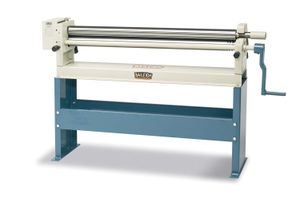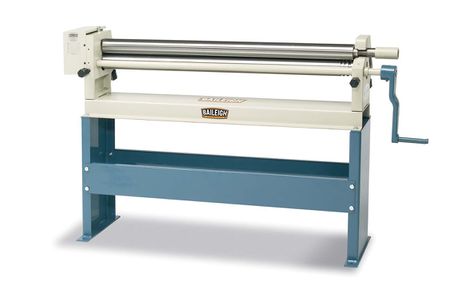Difference between revisions of "Slip Roller"
| Line 57: | Line 57: | ||
====General Procedure==== | ====General Procedure==== | ||
| − | |||
#Adjust the radius by turning the knobs on the back of the machine. This adjusts the distance between the rollers. | #Adjust the radius by turning the knobs on the back of the machine. This adjusts the distance between the rollers. | ||
| Line 66: | Line 65: | ||
#Slowly rotate the handle until you have rolled to the desired radius. If the initial radius is not the desired radius, re-roll at a slightly tighter radius. | #Slowly rotate the handle until you have rolled to the desired radius. If the initial radius is not the desired radius, re-roll at a slightly tighter radius. | ||
#Unlock the top roller to slide your rolled metal off the end of roller. | #Unlock the top roller to slide your rolled metal off the end of roller. | ||
| − | |||
==Safety== | ==Safety== | ||
Revision as of 15:53, 29 July 2020
Make: Baileigh
Model: SR-5016M
Ace: Needed (Makerhub@georgefox.edu).
Location: Machine Shop
Description
A slip roller is a machine used to roll sheet metal with a formed radius. In addition to rolling sheet metal, the roller in the shop includes wire grooves for bending solid rod. The minimum forming diameter of the roller in the shop is 4.5"
Documentation
Terminology
Training
Operation
The SawStop table saw has a unique safety feature. A spring loaded cartridge is located in the machine. Any conductive material that makes contact with the blade causes the aluminum cartridge block to fire into the blade. The blade then stops spinning and drops down out of the way. All this happens within 5 milliseconds, helping to ensure the blade inflicts minimal damage. This galvanic response safety mechanism is great for preventing injuries but will permanently damage the blade if triggered. If the material you are cutting is conductive it will trigger the saw stop feature. Do not cut any wet lumber, pressure treated, or metal coated materials such as gold leaf with this machine. Charcoal is also conductive so any laser cut areas of lumber should not make contact with the blade while cutting. There are a few other things to keep in mind regarding your material as well. Make sure the material you are cutting is free of all foreign objects. Do not cut materials that may have nails or screws as they will damage the blade and may cause injury to you. If the blade comes in contact with a conductive material (metal or human fingers), the safety mechanism will stop the saw blade by jamming a block of aluminum into the blade and probably permanently take the blade out of commission. Also, if the material contains a loose knot it can break free and create a safety hazard.
If your material looks good, the next step is to set up the saw itself. When setting up the saw the blade, it should protrude no more than 1/4" above the material top. This limits the amount of blade that is exposed and makes for a good cut. You will also want to hook up the adjacent dust collector to the rear of the machine, make sure it is plugged in, and turned on. The dust collector must be used with the table saw to help keep the dust out of the air. As you make a cut, it is imperative that you keep the wood firmly against the fence to make the cut square. Therefore, you should double check to see if you are reading the right measurement on the fence, especially because the fence can be moved to either side of the blade which is why there are two distance indicators, only one of which is correct for each set up. Make sure to ask the supervisor about the available jigs because they can be helpful for specialty cuts. Once the supervisor has demonstrated the use of a jig feel free to use it in the future but do not play around with jigs you are unfamiliar with.
After the saw is set up make sure the small dust collector is ready to go. The dust collector hose needs to be connected to the table saw exhaust port. It's a good idea to gently press against the lower dust collector bag with your hand or use the clear sight window to see how full the dust bag is prior to turning it on. If the sawdust level is above the clear sight window you need to let the supervisor know. Turn the power switch on for the dust collector. Turn on the saw main switch and wait for solid green light. Make sure the blade is clear and pull the start/stop paddle next to the main power switch and slowly push the material through, making sure to keep your hands away from the blade. Do not stop pushing the material until after the cut is finished unless there is an emergency, in which case, carefully use one hand or your hip to bump the off switch. Also not let go of your work piece during the cut or it will be forced back towards you.
Demonstration
Demonstrate you can safely setup the saw and rip a board. You will then proceed to cross cut one of the remaining pieces. Remember to set the blade height so it is protruding less than 1/4" out the top of material for less exposure. When performing a rip cut the fence is used to guide the lumber into the blade. You want to make sure that the distance between the fence and blade is the width of desired cut. Mark the edge of the material when doing a cross cut so you can align the material with the blade in the sled. You can also use a miter gauge for making cross cuts but make sure the material is long enough and well supported.
General Procedure
- Adjust the radius by turning the knobs on the back of the machine. This adjusts the distance between the rollers.
- Adjust the amount of pinch using the knobs on the front left of the machine for materials of different thickness. If the gap between the rollers is too far apart the material will slip on the rollers.
- Begin by pulling the right side of the top roller out of its slot.
- Insert your piece that you would like to roll between the rollers.
- Re-secure the top roller inside of the slot prior to rolling.
- Slowly rotate the handle until you have rolled to the desired radius. If the initial radius is not the desired radius, re-roll at a slightly tighter radius.
- Unlock the top roller to slide your rolled metal off the end of roller.
Safety
There are several hazards you need to be aware of when using the slip roll.
- #Never put your finger in between the rollers as you could crush them.
Certification
Troubleshooting
If the blade appears to need sharpening ask the tech to change out the blade.
A sign of a dull blade is as follows:
1. Burning of material
2. More resistance when cutting
3. Rough cut edges
4. Increased cutting noise
5. Increased motor noise
Maintenance
General maintenance
Keep the saw clean and use the dust collector. There are several lubrication points on the saw that need to be checked by the tech.
Specific Maintenance Tasks
| Maintenance Procedure | Frequency | Done By |
|---|---|---|
| Lubricate mechanisms | Semester | Sample |
| Clean machine interior | Monthly | Tech |
| Change the blade | As Needed | Tech |
A slip roller is a machine used to roll sheet metal with a formed radius. In addition to rolling sheet metal, the roller in the shop includes wire grooves for bending solid rod. The minimum forming diameter of the roller in the shop is 4.5"
The current Ace of the Slip Roller is Needed (Makerhub@georgefox.edu).

